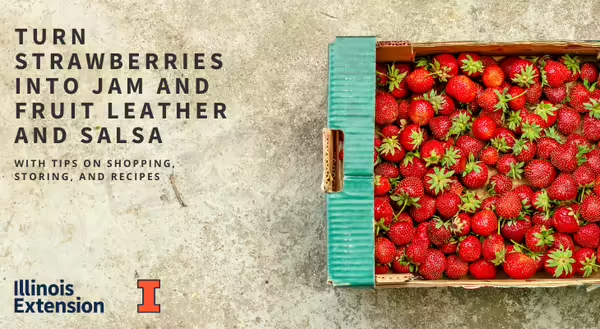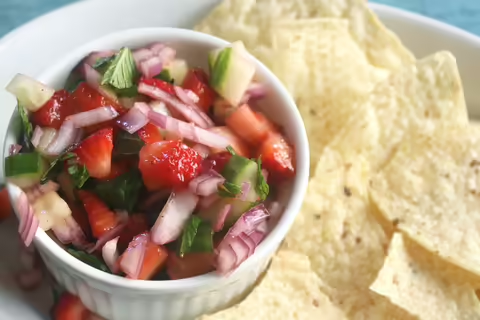
The strawberries are coming! The strawberries are coming! May is National Strawberry Month so you might start seeing sales or promotions in grocery stores and locally grown strawberries will be available soon at local farmers markets and pick-your-own sites.
Like other berries, a wonderfully ripe strawberry just bursts with juice and flavor. You can find strawberries year-round in stores, but the best quality and lowest prices will be in late spring and summer months when the berries are in-season.
A 1-cup serving of sliced fresh strawberries contains around 50 calories, 13g carbohydrates, and 3g fiber, and is a good source of vitamins and minerals, like vitamin C, folate, and potassium. Like many fresh fruits, strawberries contain no significant amounts of fat, protein, or sodium.
- Buy: Strawberries will not ripen after picking, so choose fresh strawberries that are a deep red color and are firm without bruising or mold. If choosing processed strawberries, such as frozen or pre-sliced in a refrigerator case, buy those without added sugar.
- Buy Local: Illinois has farms all over the state growing strawberries and other berries. Check out Strawberries and More from Illinois Extension for a list of farms that invite customers to pick-your-own, buy pre-picked berries, or participate in community supported agriculture subscriptions.
- Price: Fresh strawberries cost on average $2.51 per pound and frozen strawberries average $2.61, according to the U.S. Department of Agriculture. Standard containers for fresh strawberries and bags for the frozen berries both usually weigh one pound.
- Store: Since strawberries tend to spoil quickly, store unwashed berries in your refrigerator just a few days before eating. Do not store berries pre-washed, as this leads to faster spoilage. If mold appears on one or more berries, assume the mold spores have spread to other berries, even if you can't see the mold just yet. To be food-safe, throw out all the berries.
- Preserve at Home: Canning as jam or jelly, freezing whole or sliced berries, or even dehydrating as a fruit leather are all options for preserving your strawberries. Visit the National Center for Home Food Preservation through the University of Georgia for recipes and instructions. Or watch Illinois Extension educator, Mary Liz, make strawberry jam and freeze strawberries.
- Prepare: Wash strawberries just before eating. Watch Mary Liz share some tips on washing strawberries. Prepare as you want: whole, sliced, diced, etc.
- Eat: Many of us will eat strawberries as a fruit side to a meal or as a snack. But strawberries are also great in baked goods, as a topping on lettuce salads, in fruit salsa, and more.
Strawberry Cucumber Salsa | Print recipe
(serves 18, 2 Tbsp per serving)
1 cup fresh strawberries, diced
1 cup fresh cucumber, diced
1/2 cup red onion, finely diced
1/2 jalapeño pepper, finely chopped (remove ribs and seeds for less heat)
1/4 cup fresh mint, rinsed and chopped
1 tablespoon lime juice
1/4 teaspoon salt
1/8 teaspoon ground black pepper
1. Wash hands with soap and water.
2. Gently rub produce under cool running water before cutting.
3. Combine strawberries, cucumber, onion, pepper, and mint in a bowl. Toss with lime juice.
4. Add salt and pepper and stir. Serve with baked whole-grain chips or crackers.
5. Cover and refrigerate leftover salsa. Eat leftovers within 3-4 days.
Nutritional analysis per serving: 5 calories, 0g fat, 35mg sodium, 1g carbohydrate, 0g fiber, 0g protein
Source: Eat.Move.Save., Illinois Nutrition Education Programs, University of Illinois Extension.
References:
- University of Illinois Extension. Strawberries and More.
- US Department of Agriculture, Agriculture Research Service, National Nutrient Database for Standard Reference
Post originally published in 2014; content updated in 2021.
Healthy Eats and Repeat
How much difference is there between canned and frozen foods? How should you cook venison? When is the best time to buy avocados? Get answers to these questions as well as other tips, tutorials and recipes for common kitchen foods and items with University of Illinois Extension Nutrition & Wellness Educator Caitlin Mellendorf. Build your best life. Trust Extension to help.
Caitlin Mellendorf is an Illinois Extension Nutrition and Wellness Educator serving DeWitt, Macon and Piatt Counties in Central Illinois. She is a Registered Dietitian and her work focuses on helping community members gain the knowledge, skills and tools to live healthier, more nutritious lifestyles. This includes providing programs and answering questions about heart health, diabetes, food safety, food preservation, grocery shopping and cooking. You can reach Caitlin by email at chuth2@illinois.edu or call 217.877.6042.
